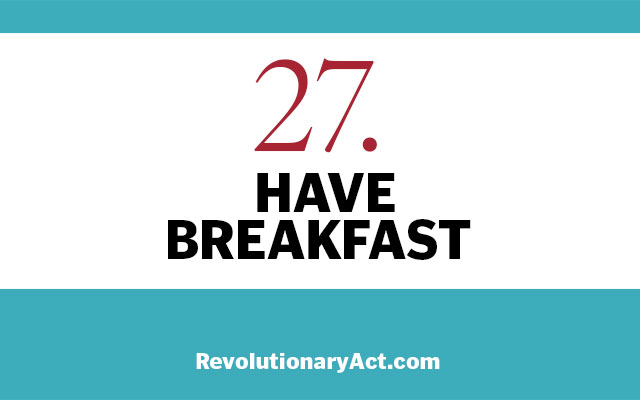Ah, breakfast. It is perhaps the most loved and loathed of all meals.
Even many of those who publicly proclaim breakfast’s status as “the most important meal of the day” privately confess that they don’t always eat it themselves.
And from what I can tell, many who do regularly eat breakfast settle for fare so nutritionally and hormonally counterproductive they might be better off eating nothing at all.
Not that I’m suggesting you skip breakfast. Hardly! But I think it’s important to acknowledge that the whole point of breakfast — literally, the breaking of your nighttime fast — is to provide enough nutrition, energy, mental focus, appetite management, and eating pleasure to get you through the first part of your day without wanting to gnaw your arm off (or worse, being tempted to bite somebody else’s head off).
And this, alas, is where most American breakfasts fail miserably, including many of the supposedly virtuous “heart healthy” options plastered all over menus.
Whole-grain bagels, bran muffins, instant oatmeal with Craisins and brown sugar, fruit plates, and juice-based smoothies — these are not ideal breakfasts for most people.
Why? Because they are low on nutrition and satisfaction, and high on glycemic load. They are unlikely to keep you sated for long, and they’re way too likely to leave you with late-morning cravings and brain fog.
Many such choices were designed around outdated nutrition guidelines that focused on reducing total fat, calories, and dietary cholesterol. Those are guidelines that many experts, including Harvard’s David Ludwig, MD, are now calling out as manipulated and scientifically misguided. They are guidelines that recent large-scale meta-analyses suggest have never had much merit, guidelines that have put some of the worst-possible breakfast foods squarely in the middle of most Americans’ breakfast plates.
Frankly, the much-reviled combination of eggs and bacon or sausage — if you can find eggs and meats that have been raised responsibly and processed intelligently, and if you can get them prepared with a side of dark leafy greens, a sweet potato, broccoli, or some other colorful vegetable, and if you don’t have an intolerance to any of those foods — are probably among the better things you can eat for breakfast.
Even so, I wouldn’t recommend that you eat that breakfast every single day. There are a few reasons for this, none of which has anything to do with calories, dietary cholesterol, or saturated fat:
- Eating the same things every single day drastically limits the diversity of nutrients in your diet.
- Our bodies tend to become intolerant of foods we overconsume or consume too regularly. (Eggs are among the top eight allergenic foods.)
- You’ll eventually get sick of most anything you eat every day, and if you don’t have some other favorites to swap in when that happens, you’ll probably be tempted to skip breakfast altogether. Which, as noted, I don’t recommend.
Here are five basic breakfasts I recommend, ones I tend to rotate through based on my mood, my energy needs, and the season.
1) The egg-and-veggie breakfast. This is just one to three eggs (depending on my energy needs and appetite) cooked any which way, combined with some sautéed or roasted veggies (typically leafy or cruciferous), and sometimes accompanied by an additional root vegetable, squash, or sweet potato for additional substance. You can cook these things up simply, combine them into a frittata, or enjoy them however you like. I mostly just sauté them all in a cast-iron pan with butter and call it good.
2) The meat-and-veggie breakfast. This is the same idea as above, but with a nice helping of responsibly raised sausage or bacon, or a leftover meat in place of the eggs. (If I’m really hungry, or I know I’m not going to be able to eat again for a while, I might also add an egg or two for good measure.)
3) Quick-Trick Snack Stack. I invented this breakfast for busy mornings when I had no time or inclination to cook, but then I liked it (and its effects) so much that I started enjoying it as an anytime-snack option. It’s basically a half cup of seasonal, low-glycemic fruit (berries or chopped apple are my faves), a generous handful each of nuts and flaked coconut, a tablespoon or two of seeds, and an optional teaspoon or so of currants (or another dried fruit chopped up very small). To this you add some whole-fat unsweetened milk (I like hemp, coconut, or flax) or whole-fat organic yogurt. Then you eat it with a spoon, like cereal. For instructions, a how-to video, and recipes, see “Revolutionary Resources,” below.
4) Substantial smoothie. The base of this is almost always whole foods — some berries, some nuts or seeds, some vegetables (I like cucumber, celery, zucchini, and leafy greens), and water. To that I might add some whole-fat yogurt and some protein or collagen powder. I often also add a scoop of supergreens and a tablespoon of omega-3 oil blend. I go easy on the fruit and fruit juice, and I strive to get in as much protein and healthy fat as I can to keep the glycemic load low and the energy long-lasting.
5) Loaded oatmeal or gluten-free hot cereal. I eat this rarely, and only in winter when I’m craving it. The key is to choose slower-cooking, whole-kernel or rough-ground grains, and then add a really significant quantity of nuts, seeds, and butter, cream, or coconut oil to the mix — plus some berries or a chopped apple — to keep fiber and phytonutrients up and glycemic load down. Adding fat and nuts also really helps with appetite and energy management. If I choose to eat this kind of grain-rich breakfast, I make sure to eat a side of sausage, a couple of eggs, or some leftover meat as a side; otherwise, the protein content tends to be too low to keep up my energy.
If none of these options appeals to you, try my basic suggestions for coming up with your own healthy breakfasts:
Focus on the fab four. Build your breakfast primarily from protein, fat, phytonutrients, and fiber. That takes the most common American breakfasts (cereal and pastries) out of the game.
Ditch instant oatmeal. It is powdered to such a fine dust that your body digests and turns it into sugar very quickly. This gives you the -dreaded blood-sugar spike and crash, which leads to excessive insulin release and the inflammatory and fat-storage effects that come with it. If you like oatmeal, have steel-cut oats or long-cooking oats (which digest more slowly), and see my hot-cereal suggestions (No. 5) for minimizing glycemic load and upgrading nutrition.
Don’t count on just coffee. I get the whole “Bulletproof” thing, and I know it spares people the sugar and gluten to which so many are sensitive, while also giving them a nice dose of healthy brain-feeding fats. But I think a lot of folks have gone a little nuts with their coffee-plus-oil combos, relying on them as a primary source of fuel for hours at a time and eschewing food until way too late in the day. If you like to start your day with coffee, go for it, but then get some real food into your system, too.
Revolutionary Resources
“Pilar’s Quick-Trick Snack Stack” — My fast-and-easy method for assembling a nutritious, gluten-free,
no-cook breakfast that tastes great.
“Learn How to Make a Whole-Food Smoothie” — A low-glycemic breakfast drink made entirely of nutrient-dense whole foods, via Mark Hyman, MD.
“Be a Breakfast Believer” — Why breakfast matters, and what to do
about it.
“Healthy Breakfasts for Busy Mornings” — A fleet of smart day-starting suggestions.




This Post Has 0 Comments